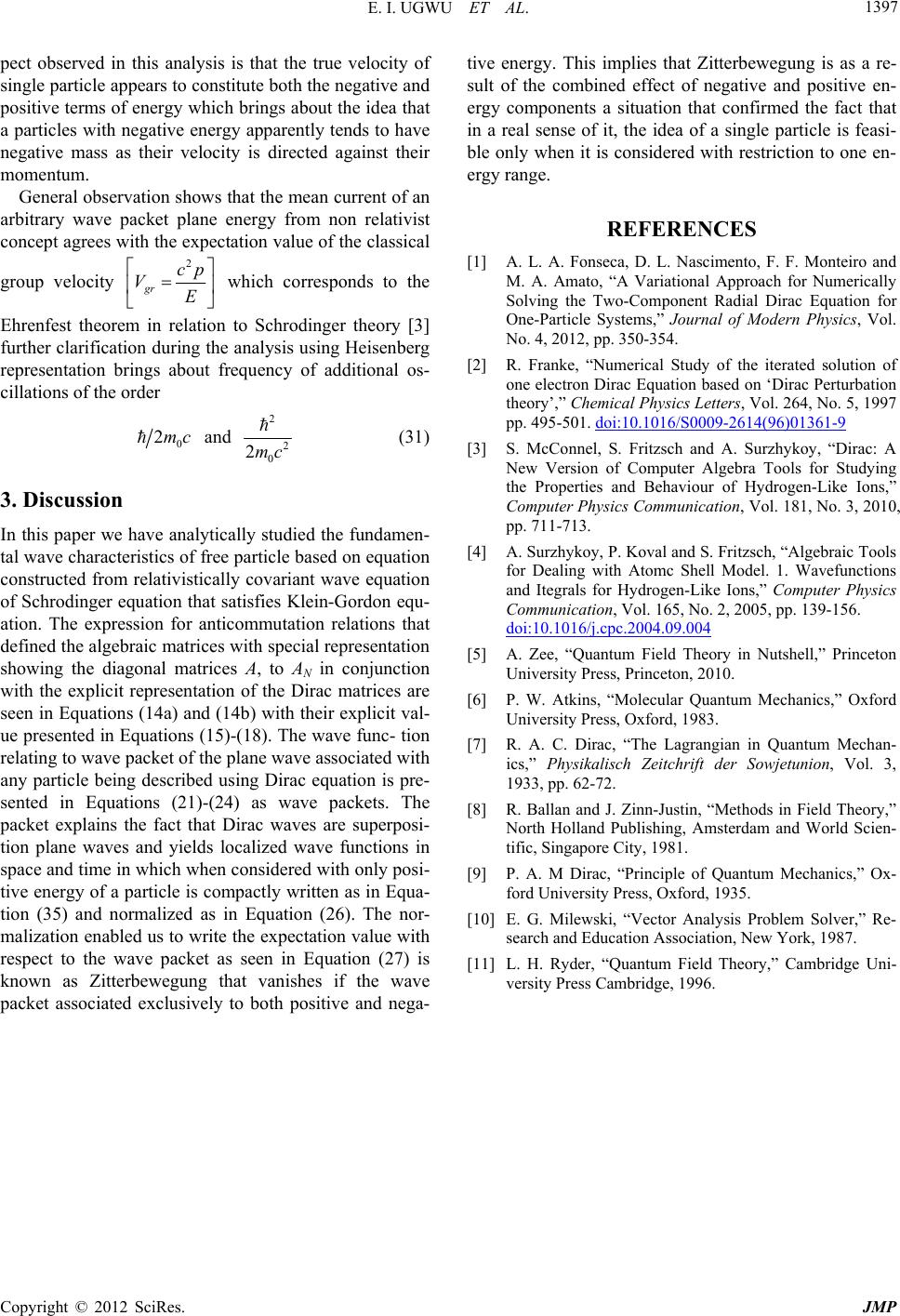
E. I. UGWU ET AL.
Copyright © 2012 SciRes. JMP
1397
pect observed in this analysis is that the true velocity of
single particle appears to constitute both the negative and
positive terms of energy which brings about the idea that
a particles with negative energy apparently tends to have
negative mass as their velocity is directed against their
momentum.
General observation shows that the mean current of an
arbitrary wave packet plane energy from non relativist
concept agrees with the expectation value of the classical
group velocity
2
gr cp
VE
which corresponds to the
Ehrenfest theorem in relation to Schrodinger theory [3]
further clarification during the analysis using Heisenberg
representation brings about frequency of additional os-
cillations of the order
0
2mc and
2
2
0
2mc
(31)
3. Discussion
In this paper we have analytically studied the fundamen-
tal wave characteristics of free particle based on equation
constructed from relativistically covariant wave equation
of Schrodinger equation that satisfies Klein-Gordon equ-
ation. The expression for anticommutation relations that
defined the algebraic matrices with special representation
showing the diagonal matrices A, to AN in conjunction
with the explicit representation of the Dirac matrices are
seen in Equations (14a) and (14b) with their explicit val-
ue presented in Equations (15)-(18). The wave func- tion
relating to wave packet of the plane wave associated with
any particle being described using Dirac equation is pre-
sented in Equations (21)-(24) as wave packets. The
packet explains the fact that Dirac waves are superposi-
tion plane waves and yields localized wave functions in
space and time in which when considered with only posi-
tive energy of a particle is compactly written as in Equa-
tion (35) and normalized as in Equation (26). The nor-
malization enabled us to write the expectation value with
respect to the wave packet as seen in Equation (27) is
known as Zitterbewegung that vanishes if the wave
packet associated exclusively to both positive and nega-
tive energy. This implies that Zitterbewegung is as a re-
sult of the combined effect of negative and positive en-
ergy components a situation that confirmed the fact that
in a real sense of it, the idea of a single particle is feasi-
ble only when it is considered with restriction to one en-
ergy range.
REFERENCES
[1] A. L. A. Fonseca, D. L. Nascimento, F. F. Monteiro and
M. A. Amato, “A Variational Approach for Numerically
Solving the Two-Component Radial Dirac Equation for
One-Particle Systems,” Journal of Modern Physics, Vol.
No. 4, 2012, pp. 350-354.
[2] R. Franke, “Numerical Study of the iterated solution of
one electron Dirac Equation based on ‘Dirac Perturbation
theory’,” Chemical Physics Letters, Vol. 264, No. 5, 1997
pp. 495-501. doi:10.1016/S0009-2614(96)01361-9
[3] S. McConnel, S. Fritzsch and A. Surzhykoy, “Dirac: A
New Version of Computer Algebra Tools for Studying
the Properties and Behaviour of Hydrogen-Like Ions,”
Computer Physics Communication, Vol. 181, No. 3, 2010,
pp. 711-713.
[4] A. Surzhykoy, P. Koval and S. Fritzsch, “Algebraic Tools
for Dealing with Atomc Shell Model. 1. Wavefunctions
and Itegrals for Hydrogen-Like Ions,” Computer Physics
Communication, Vol. 165, No. 2, 2005, pp. 139-156.
doi:10.1016/j.cpc.2004.09.004
[5] A. Zee, “Quantum Field Theory in Nutshell,” Princeton
University Press, Princeton, 2010.
[6] P. W. Atkins, “Molecular Quantum Mechanics,” Oxford
University Press, Oxford, 1983.
[7] R. A. C. Dirac, “The Lagrangian in Quantum Mechan-
ics,” Physikalisch Zeitchrift der Sowjetunion, Vol. 3,
1933, pp. 62-72.
[8] R. Ballan and J. Zinn-Justin, “Methods in Field Theory,”
North Holland Publishing, Amsterdam and World Scien-
tific, Singapore City, 1981.
[9] P. A. M Dirac, “Principle of Quantum Mechanics,” Ox-
ford University Press, Oxford, 1935.
[10] E. G. Milewski, “Vector Analysis Problem Solver,” Re-
search and Education Association, New York, 1987.
[11] L. H. Ryder, “Quantum Field Theory,” Cambridge Uni-
versity Press Cambridge, 1996.